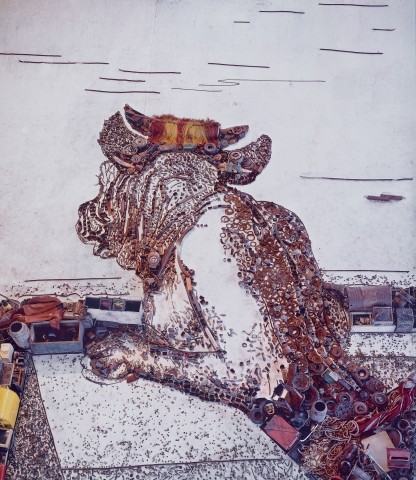MINOTAUR AFTER GEORGE FREDERICK WATTS (FROM PICTURES OF JUNK), 2006
VIK MUNIZ
Type C print
127.0 x 101.5 cm (sight)
signed, dated and numbered on gallery label verso
Sikkema Jenkins & Co., New York (label attached verso)
Private collection
Sotheby’s, New York, 12 June 2014, lot 338
Shannon Bennett, Melbourne
Pictures of Junk, Sikkema Jenkins & Co, New York, 9 September – 14 October 2006
Corrêa do Lago, P., Vik Muniz: Obra Completa 1987–2009, catalogue raisonné, Capivara, Rio de Janeiro, 2009, p. 561 (illus., another example)
Another example of this print is held in the collection of the Christen Sveaas Art Foundation, Norway
Vik Muniz is a Brazilian-born, New York based contemporary artist working at the intersection of sculptural installation, drawing, and photography. An enduring fascination with the fundamental mechanics of image perception has underpinned his practice since the 1980s. His whimsical photographed compositions, portraits and re-created historical paintings, are ‘drawn’ with inventive, unconventional means: tracing lines and patterns through the three-dimensional forms of poured foodstuffs, piled industrial detritus or collaged scraps of coloured papers. His process of upcycling and salvaging of refuse destined for landfill, enables the artist to imagine another iteration for the material existence of such items, often using the origins of his materials to provide another layer to his imagery, particularly concerning sustainability and social inequality. Muniz attributes this tendency to use layered imagery and metaphors to the experience of living under military dictatorship in Brazil – ‘you cannot trust information or dispense it freely because of censorship, they [Brazilians] learn to communicate with double meanings’. 1
Minotaur, after George Watts, comes from a series Muniz called “Pictures of Junk”, where he recreated Old Master paintings using rubbish on a large scale and then photographed them from a distanced, high vantage point. The resulting trompe l’oeil contains discrepancies of scale and perspective, as the relative densities of piled detritus coalesce into recognizable forms of the original painting. While a painted picture is created by placing different coloured brushstrokes that the mind stitches together into a legible image, the same process is utilized by Muniz, only with different base units. Accumulated and placed on a football-field sized clearing outside of Rio with the help of art students from local favelas, his pigments are the post-industrial refuse of nuts and bolts, tires, barrels, hubcaps, ropes and even a pedestrian crossing street sign, left apparent in the composition for those viewers using their short-distance visual perception.
Bridging the gap between representation and material substance, Muniz’s pictures of junk are deceptively figurative. In Minotaur (and other pictures from this series) the figurative forms of this mythological creature, half-man and half-bull, are created using the negative space between piles of objects. The mythological creature who terrorized King Minos’ Cretan society, was originally described as snow-white, a monster derived from lustful and unnatural human impulses. British neoclassical and symbolist painter, George Watts painted Minotaur in 1885 as an allegory for man’s destructive and bestial nature, a strong comment in favour of the Criminal Law Amendment Act of the same year, concerning a regulation of child sexual exploitation.2 While the crux of Watts’ allegory lay in a small bird that was pictured crushed in the minotaur’s fist, this detail is not visible amongst the rough industrial forms of Muniz’ appropriation. The environmental impact and social inequality of man’s destructive nature, however, becomes the allegory for Muniz, his junk a symbol of flawed ideals, of earthly failure and repetitive cycles of excess and destruction.
Vik Muniz, originally from Sao Paulo, has reached a significant level of international acclaim. Having already represented Brazil at the Venice Biennale, he was honoured in 2009 with a large retrospective exhibition at the Museum of Modern Art, in New York, then touring Rio de Janiero and Sao Paulo. The social activism within in Muniz’s collaborative projects in Brazil have since become the main focus of the artist’s practice in recent years.
1. Kino, C., The New York Times, 21 October 2010
2. In the collection of the Tate, London [https://www.tate.org.uk/art/artworks/watts-the-minotaur-n01634]
LUCIE REEVES-SMITH
